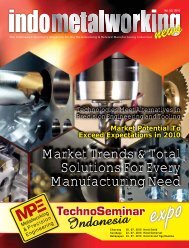High Speed Machining Precision Tooling - Indobiz.biz
High Speed Machining Precision Tooling - Indobiz.biz
High Speed Machining Precision Tooling - Indobiz.biz
You also want an ePaper? Increase the reach of your titles
YUMPU automatically turns print PDFs into web optimized ePapers that Google loves.
Just how good is your<br />
process?<br />
Check your O.E.E. and find out<br />
There is no better statistical tool to<br />
use when evaluating the all-around<br />
effi ciency of a production process<br />
than Overall Equipment Effectiveness.<br />
O.E.E. is a simple series of formulas that<br />
be can used with any calculator and<br />
some basic data that are most likely<br />
currently at your disposal. There are 3<br />
factors within the production process<br />
that are evaluated using O.E.E.<br />
• Availability: The actual uptime of<br />
the process divided by the scheduled<br />
available runtime. Example: The<br />
scheduled runtime was 7.2 hours (432<br />
minutes). A broken parts feeder stopped<br />
production for 45 minutes. The uptime<br />
for the shift was 387 minutes. 387/432<br />
= 0.89583 or 89.6 percent.<br />
Bottom line– Availability represents<br />
machine breakdowns.<br />
• Performance efficiency (P.E.): During<br />
the actual uptime, how effi cient was the<br />
process when compared the designed<br />
optimum cycle time. Example: The<br />
optimum cycle time for the process<br />
is 15 seconds per part or 4 parts per<br />
minute. For 387 minutes of uptime, the<br />
process would produce 1548 parts if it<br />
never stopped once. During our shift,<br />
we produced 1357 parts. 1357/1548 =<br />
0.87661 or 87.7 percent.<br />
Bottom line- Performance effi ciency<br />
represents short stoppages of the<br />
process.<br />
• Rate of quality product (R.O.Q.P):<br />
Of the total number of parts produced<br />
during the uptime, what percentage was<br />
conforming. Example: During our 387<br />
minutes in which we produced 1357<br />
parts, 14 were defective and 12 need<br />
re-worked. 1331 conforming parts were<br />
made. 1331/1357 = 0.9808 or 98.1<br />
percent.<br />
Bottom line- Lower your in-process<br />
scrap and rework.<br />
The Overall Equipment Effectiveness is<br />
computed by the formula – Availability x<br />
P.E. x R.O.Q.P.<br />
0.896 x 0.877 x 0.981 equals 77.1<br />
percent, which is our O.E.E. for this<br />
process.<br />
A “World Class” process would produce<br />
a consistent 85 percent O.E.E. (or<br />
an average of 95 percent in each<br />
category).<br />
There are some simple items to look at<br />
for an O.E.E. improvement. Availability<br />
deals with scheduled uptime. Be<br />
sure routine items such as machine<br />
changeovers, preventive maintenance,<br />
and department meetings are scheduled<br />
through the production controller<br />
(however titled) at your facility.<br />
Improving P.E. means correcting a short<br />
stoppage before the cycle time is lost.<br />
Never lose sight of the parts counter at<br />
the end of the process. Some processes<br />
are made up of smaller stations with<br />
their own unique cycle times. The<br />
stations form a chain and the optimum<br />
cycle time of the process will be the<br />
cycle time of the slowest station. This is<br />
benefi cial because it can be determined<br />
which stations are capable of “catching<br />
up” after a stoppage. If more than one<br />
stoppage occurs at the same time, it may<br />
be best to correct them from the closest<br />
to the end of the process and then work<br />
backwards towards the beginning.<br />
This goes against conventional thinking.<br />
If a stoppage occurs down toward the<br />
end of the process and at the same time<br />
a machine jams up right in front of you<br />
(while you’re at the front of the process),<br />
it may be better to walk down to clear<br />
the other stoppage fi rst. The reason<br />
behind this is if the stoppage down the<br />
line is not fi xed fi rst, it is possible the<br />
last process will run out of parts. Each<br />
and every 15 seconds is lost forever. By<br />
fi xing the stoppages toward the end of<br />
the line fi rst, you have a better chance<br />
of parts “catching up” and there will be<br />
no cycle time lost at the last process.<br />
In some situations any stoppage will<br />
shut the entire process down. In that<br />
case I would suggest placing re-settable<br />
trip counters at various intervals. When<br />
a stoppage occurs, the operator can trip<br />
the counter. After a week of production,<br />
the counters will tell you where the most<br />
stoppages are occurring and further<br />
evaluation can be planned.<br />
R.O.Q.P. is too product-specifi c to be<br />
discussed in the article. If your facility<br />
doesn’t have an organized quality<br />
system, I suggest developing one.<br />
Remember that no system will be any<br />
better than the operators who use<br />
it. Machines make parts, but people<br />
make products. Keep an open mind and<br />
always, always, always be creative.<br />
indometalworking news Vol. 2 / 2008 37




